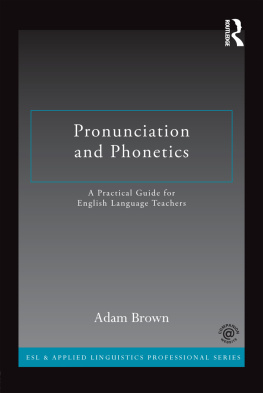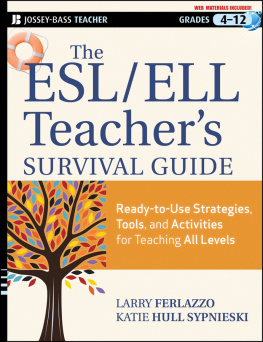for the First Edition (1979)
I should like to acknowledge my special indebtedness to Hugh LEstrange who read this book and made lots of useful suggestions (and who also helped out with the typing when one finger proved too slow!).
I should also like to thank Frances Newman and John Johnson of Kingsway-Princeton College of Further Education, London for their excellent ideas (see particularly ) and also Dr David Thomas of the University of Bristol, Department of Drama.
for the Second and Third Editions (2011, 2013)
Many thanks to Bob Janes for his tremendous support and encouragement, and for all his hard work in putting the book together and giving it a more modern and attractive look.
Also to Andy Cowle for his enthusiasm and committment to making this series available to teachers again years later, and to HarperCollins for taking it under their wing.
J ane Revell is an award-winning ELT author who has worked globally in ELT as an educator, manager and trainer since the early 70s. She is widely known in many countries and is greatly respected for her continued contributions and inspiring workshops. Jane is also a Master Practitioner and Certified Trainer of NLP, and a Pilates instructor.
www.janerevell.com

T eaching Techniques for Communicative English was the very first book I ever wrote and its now just over thirty years old. (Unlike me.)
We decided to publish a new edition because the ideas in the book are still valid today and because it contains a lot of useful advice for teachers and a fair amount of food for thought.
When it was first published in 1979 as the first in a new series of teachers books for Macmillan it was quite radical. The 1970s was an era of great change in English Language Teaching, of attempts to put into practice many new theories about language being proposed by linguists at that time. Today we are very familiar with concepts such as functions, notions, social context, appropriateness and so on but in those days they were fairly new ways of thinking about language. But while the book is no longer ground-breaking, many of the issues it talks about still remain. Creating classroom activities which really get students communicating with one another in a natural and meaningful way is still very challenging. We still havent quite cracked it! The classroom is somewhat unnatural by its very nature so perhaps we never will. This book doesnt pretend to have the answer either but it does attempt to offer some helpful techniques.
Reading through the book for the first time in many years I was struck at how fresh it seems. Fresh and, at the same time, a little bit quaint. I have tried not to meddle too much with either its freshness or its quaintness. I have made a few cuts and one or two small changes, but basically I have left it intact: I have left the original newspaper articles and made minimal changes to dialogues, role cards and so on. I have updated things where necessary zoo prices, for example, have gone up from 1.60 in 1979 to 16.80 in 2009 and
I have replaced the photographs, which looked dated, even though teachers will of course be able to download their own visual material from the Internet these days.
The use of the pronoun he (practically throughout) irritated me a lot so I have dealt with that. I have also made changes to the tense used in some instances, as what was recent then, no longer is. Where the text was too categorical or bossy, I have toned it down and made it more tentative.
And I have added a few things too. Some websites have been added to the Useful Addresses section at the end; the original Bibliography and Practical Material sections have both been left for historical interest and there is a new Useful Books/Sources of Ideas section though several of the original books are still included here.
Enjoy!
Jane Revell,
I am a teacher of English as a foreign language and at the moment I am learning German as a foreign language in what I would say is a very non-communicative way. For three whole hours every morning we listen to the teacher explain rule after rule before we move on to apply these rules in exercise after exercise in the book. In the street after the lesson, I need to know where the 53 bus stops. There is a lady coming. By the time I have managed to formulate my question in German, the lady has gone past. I ask the next passer-by, and expect short and easy-to-follow directions. Instead he says in German, Oh youve just missed one. Actually Im going towards the Haus der Kunst, so I could give you a lift if you like. My cars right over there. Wie bitte?! (Pardon?). I am unable to communicate successfully in German, even on a very simple level. Why? For the reasons lets go back to the classroom.
In my German class I normally get to say something about once every hour, when I read out a sentence from an exercise or text. I always talk to the teacher and never to any of the other students, and I never decide what to say, as its written in the book for me. No wonder when I come out to face the real world I am thrown! Its true that this is a very extreme example, and luckily, because I am living in Germany and surrounded by German, my German lessons are unlikely to be a permanent obstacle to successful communication in the language. For foreign learners of English outside an English-speaking environment, however, the problem could be a very serious one.
In coping with a foreign language, confidence plays a very large part. Students need to feel that they will be able to apply what they have learnt in the classroom to real life, and be able to tackle many different situations in a foreign language in a foreign country. It is up to the teacher to give the students this confidence, by providing plenty of opportunities for them to practise what they have learnt in as realistic a way as possible inside the classroom.
Very often teachers are tied to a specific book and are aiming to get their students through an exam which tests specific items in that book. Even in this situation, which is far from ideal, there is room for communicative activities, activities in which the students can transfer their learning to real situations.
Suppose the teacher is working with Alexanders First Things First at Lesson 77, for example. Rather than just practise everything in the way suggested in the Teachers Book and move quickly on to the next lesson, the teacher might think about an activity where the students can practise the structures they have learnt (I want to and, Cant you wait till ?) in a similar situation, but in a way which allows them to think and to use language more creatively. They could work in pairs, for example, one as the receptionist, who has some pages from a diary in which certain days and times are booked up, and one as the person who wants to make the appointment. Between them they must work out a suitable time.
The activities described on the following pages are of this type. They can be used on their own or they can be used alongside any standard textbook and slotted in at appropriate moments to provide a transfer stage in the lesson. They are activities (particularly the later ones), designed to give learners a chance to experiment with their new linguistic skills, to be more creative. Activities, in short, to bridge the gap between skill-getting in the classroom and skill-using in real life.















